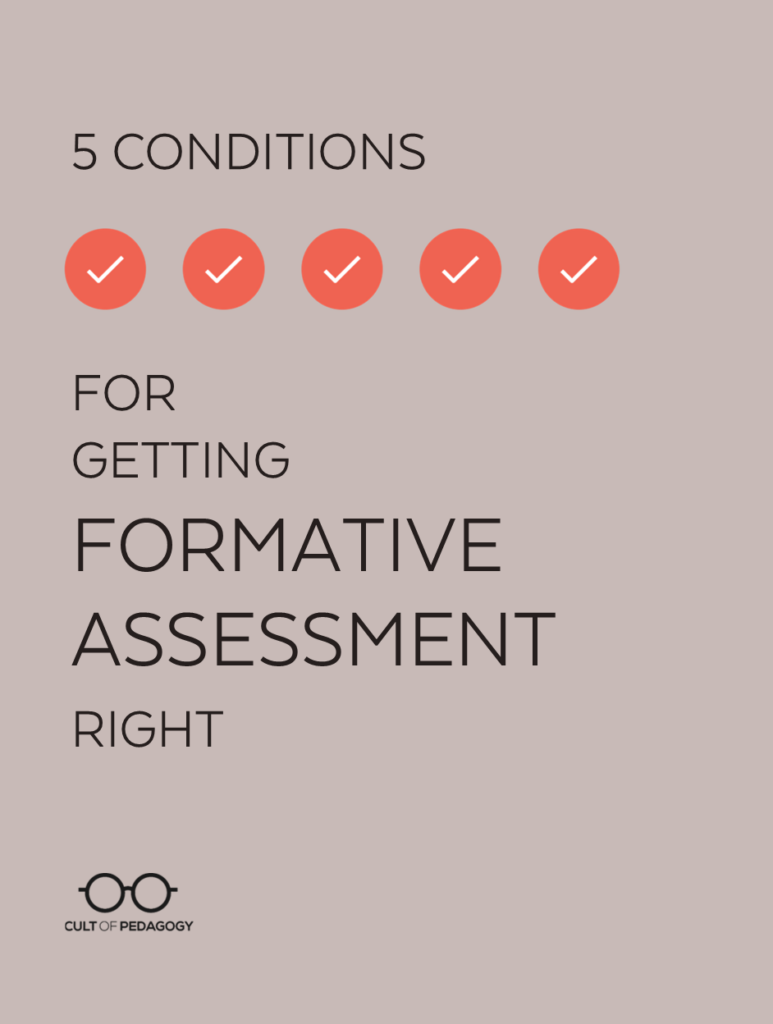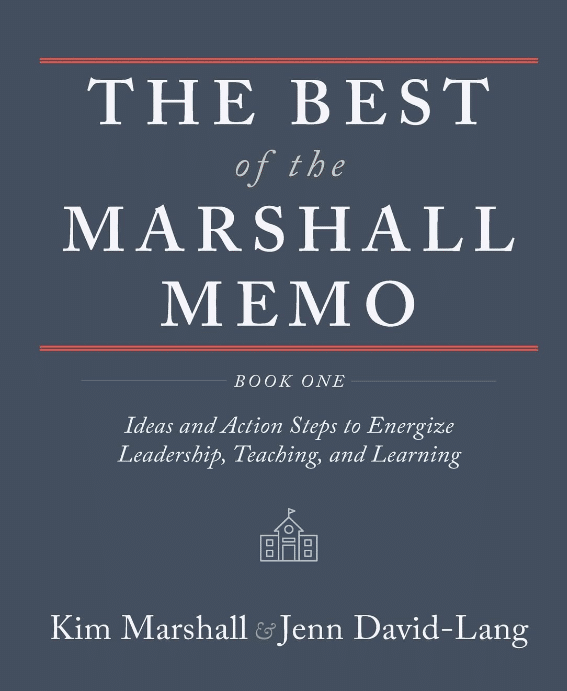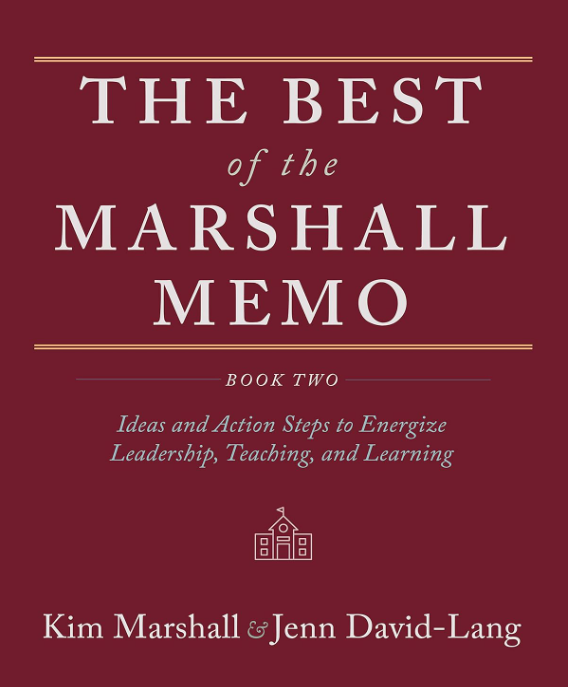
Listen to my interview with Kim Marshall and Jenn David-Lang (transcript):
Sponsored by Listenwise and Scholastic Magazines+
This page contains Amazon Affiliate and Bookshop.org links. When you make a purchase through these links, Cult of Pedagogy gets a small percentage of the sale at no extra cost to you. What’s the difference between Amazon and Bookshop.org?
Any time we teach our students something, we need to check to see how well they learned it. The most common way to do this is with some kind of a test, which traditionally happens at the end of a unit — a final exam of some kind. But if we only do this check at the very end, after all the teaching is done, and we find that our students haven’t learned the material quite well enough, it’s too late to do anything about it. That’s why we really need to be checking as we go, so if there are problems, we can fix them.
We call these two kinds of testing summative assessment, the kind that happens at the end, and formative assessment, the kind that happens during the learning cycle. For now we’re going to focus on formative assessment — specifically, five things we need to do to make sure we get it right, because if we do, we can dramatically improve our students’ learning.
Helping me do this are Kim Marshall and Jenn David-Lang, two people who have put some serious time into figuring out what works in the classroom. Kim Marshall is the force behind the highly regarded Marshall Memo, a weekly, subscription-only summary of 8 to 10 of the most impactful articles in education. Since 2003, he has published 50 issues of the Memo every year, and countless educators rely on his summaries to stay on top of what’s happening in education.


Jenn David-Lang, meanwhile, has been doing a similar project since 2007, when she began publishing The Main Idea, a single, detailed monthly summary of an important education book to help education leaders connect to the most important ideas on leadership, teaching, and learning.
A few years ago, the two joined forces to publish The Best of the Marshall Memo, a “super-curation” of the very best Memo summaries in two volumes. Since then, supported by a foundation grant, they have made these summaries available for free on their website, bestofmarshallmemo.org. The collection is sorted into 24 categories, one of which is assessment.
The five conditions for formative assessment that we talked about on the podcast come straight from that collection. The interview and full transcript are above; below is a quick summary of what we talked about.
1. Respond to the Results
Giving a formative assessment is pointless if we don’t do something in response to the results.
“If you do a formative assessment and 30, 40, 50, 80 percent of your kids don’t understand the concept you are trying to teach, then what?” David-Lang says. “You can’t just say, I taught it and then it was learned. It was not learned.”
Ideally, she says, teachers should have a plan B written into their lesson plans, a next step for what to do for students who show that they aren’t getting it. This could include:
- doing a turn and talk where students try to “convince their neighbor” that their understanding is correct
- reteaching the concept to a small section of the class while the rest work independently
- setting up stations ahead of time that offer instruction for the different ways kids might have misunderstood the concept
2. Choose a System that Checks All Students
Asking your class if they have any questions, or even doing a “thumbs up, thumbs down” check on understanding is highly unlikely to help you determine which students need help. For your formative assessment to work, whatever system you’re using has to check every student’s understanding.
There are high-tech ways to do this — clickers, response systems like Formative, Google Forms, and apps that only require one device like Plickers. You can also go low-tech by simply asking a question and having students write a response on an individual whiteboard or hold a number of fingers (e.g., 1, 2, 3, or 4) against their chest to indicate their answer.
Which leads us to the next condition: The question itself has to be a good one.
3. Ask Good Hinge Questions
Effective formative assessment doesn’t need to be lengthy; in fact, a lot can be accomplished with a single hinge question (a term coined by educator Dylan Wiliam), which will determine how the rest of a lesson goes depending on how students answer.
The construction of that question is key.
“In one of the articles we summarized, Craig Barton says we learned in teacher school that open-ended questions are best, right?” explains David-Lang. “Why did the Civil War happen? How do you know which is bigger: Three-sevenths or four-elevenths? But in fact, it actually helps to have a closed question if you really want to check for understanding.”
A yes/no question or true/false question could lead to students just guessing correctly by chance, whereas a well-constructed multiple-choice question can give you the most meaningful results if you make each choice represent a different kind of misunderstanding.
For example, David-Lang says, a good question could say, “The apostrophe is used a) to separate items in a list, b) when you want to introduce a quotation, c) when you want to shorten words like do not to don’t, d) when you want to show possession. So let’s say 90 percent of your class says it’s to separate items in a list. Oh, I didn’t distinguish between commas and apostrophes.”
4. Keep Checks for Understanding Brief and Frequent
Delivering long blocks of direct instruction without stopping to assess can lead to big gaps in learning. Marshall recommends stopping at least three or four times during direct instruction to perform a cycle consisting of “question, poll results, convince your neighbor, consolidate, move on.” He points to Harvard professor Eric Mazur‘s discovery that pausing his lectures periodically, checking for student understanding, and then allowing students to teach each other to correct misconceptions was a game-changer for getting more students to master his material.
David-Lang explains that when it comes to formative assessment, speed and frequency go hand in hand. “It’s like a dipstick. You stick it in, and Oh, my oil’s low. It’s a quick check; it shouldn’t be burdensome to teachers. There’s no stack of papers to grade. It’s on the spot, right there. If you can make it more manageable for yourself, then you’re more likely to do it more regularly as well.”
5. Create a Culture That Normalizes Mistakes
“When you create a classroom that’s focused on the rewards, the gold stars, the grades, kids are just trying to look good and get the good grade,” David-Lang says. “What we want is a classroom that’s focused more on the learning, the idea that if you didn’t get it the first time, that’s okay. You can learn. You want to create the kind of culture where formative assessments are not intimidating. You have to make it very clear these are low stakes, nothing’s going in the grade book. When kids are like, oh, I’m not getting graded on this? I can be more honest, more vulnerable. Then the learning improves, and it’s this whole cycle where the culture improves the formative assessment, and the formative assessment improves the culture.”
Marshall shares an acronym used by educator Jeff Howard to normalize mistakes: “He has a thing called FADAF: Failure and difficulty are feedback. And he actually teaches this to kids, FADAF, you know, You got to FADAF this one.”
Making the Most of an Already Powerful Strategy
David-Lang points out that formative assessment is something a lot of teachers are already doing, and that it has the potential to be so powerful, but only if it’s done right.
“I think Hattie says it doubles learning if it’s done well. So I think that’s what Kim and I are trying to say about these five main points — you walk into a classroom, you see exit tickets, right, without a doubt. But is it, does it include these five main criteria? And is it being done well? Because that’s what doubles the learning — same curriculum, same teacher with and without formative assessment done well, it’s a difference in years’ worth of learning. That’s kind of incredible.”
Join our mailing list and get weekly tips, tools, and inspiration that will make your teaching more effective and fun. You’ll get access to our members-only library of free downloads, including 20 Ways to Cut Your Grading Time in Half, the e-booklet that has helped thousands of teachers save time on grading. Over 50,000 teachers have already joined—come on in.






